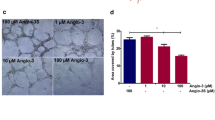Abstract
Endostatin, a potent endogenous inhibitor of angiogenesis, inhibits the growth of primary tumors without induction of acquired drug resistance in mice. We report that a soluble recombinant human (rh) Endostatin produced with characteristics of the native Endostatin, effectively inhibited the growth of primary tumors and pulmonary metastases in a dose-dependent manner. We also show that deletion of two of the four zinc ligands of rhEndostatin did not affect this potent tumor inhibiton. The growth of established Lewis lung primary tumors implanted into mice was inhibited (80–90%) upon systemic treatment with 50 mg/kg/12 h of rhEndostatin. Using the B16-BL6 murine experimental pulmonary metastases model, rhEndostatin administered at 1.5 mg/kg/day or 4.5 mg/kg/day beginning 3- or 11-days post tumor cell injection, respectively, resulted in an approximate 80% inhibition of tumor growth. At effective anti-tumor doses of 1.5 and 50 mg/kg, pharmacokinetic modeling in mice showed (a) the protein was 100% bioavailable, (b) the AUC ranged from 16 to 700 ngml/h and (c) the Cmax ranged from 161 to 4582 ng/ml. At the highest dose tested (300 mg/kg), delivered as a single bolus, no drug-related toxicity was observed in a Cynomolgus monkey infused with rhEndostatin. No toxicity was observed even at AUC and Cmax values that were 1.3- to 56-fold higher than those observed in mice with tumors that were potently inhibited. Our production system yields a well characterized, soluble and potent rhEndostatin at quantities sufficient for human use. The preclinical studies described herein are an important first step toward the assessment of Endostatin in the clinic.
Similar content being viewed by others
References
Folkman J. Tumor angiogenesis: therapeutic implications. N Engl J Med 1971; 285: 1182–6.
O'Reilly M, Boehm T, Shing Y et al. Endostatin: An endogenous inhibitor of angiogenesis and tumor growth. Cell 1997; 88: 277–85.
Boehm T, Folkman J, Browder T et al. Antiangiogenic therapy of experimental cancer does not induce acquired drug resistance. Nature 1997; 390: 404–5.
Dhanabal M, Ramachandran R, Volk R et al. Endostatin: Yeast production, mutants, and antitumor effect in renal cell carcinoma. Cancer Res 1999; 59: 189–97.
Hohenester E, Sasaki T, Olsen B et al. Crystal structure of the angiogenesis inhibitor endostatin at 1.5 A resolution. EMBO 1998; 17: 1656–64.
Ding Y, Javaherian K, Lo K et al. Zinc-dependent dimers observed in crystals of human endostatin. Proc Natl Acad Sci 1998; 98: 10443–8.
Boehm T, O'Reilly M, Keough K et al. Zinc-binding of endostatin is essential for its antiangiogenic activity. Biochem Biophys Res Commun 1998; 252: 190–4.
Oh S, Warman M, Seldin M et al. Cloning of cDNA and genomic DNA encoding human type XVIII collagen and localization of the α1 (XVIII) collagen gene to mouse chromosome 10 and human chromosome 21. Genomics 1994; 19: 494–9.
Chang Y, Zajicek J, Castellino F. Role of tryptophan-63 of the kringle 2 domain of tissue-type plasminogen activator in its thermal stability, folding, and ligand binding properties. Biochemistry 1997; 36: 7652–63.
Hart IR. The selection and characterization of an invasive variant of the B16 melanoma. Am J Path 1979; 97: 587–600.
Sato Y, Rifkin D. Autocrine activities of basic fibroblast growth factor: Regulation of endothelial cell movement, plasminogen activator synthesis, and DNA synthesis. J Cell Biol 1988; 107: 1199–205.
Sim K, O'Reilly M, Liang H et al. A recombinant human angiostatin protein inhibits experimental primary and metastatic cancer. Cancer Res 1997; 57: 1329–34.
Author information
Authors and Affiliations
Rights and permissions
About this article
Cite this article
Sim, B.K.L., Fogler, W.E., Zhou, X.H. et al. Zinc ligand-disrupted recombinant human Endostatin: Potent inhibition of tumor growth, safety and pharmacokinetic profile. Angiogenesis 3, 41–51 (1999). https://doi.org/10.1023/A:1009058931769
Issue Date:
DOI: https://doi.org/10.1023/A:1009058931769




